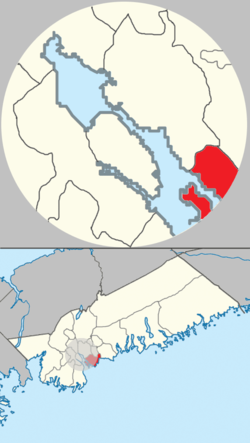Eastern Passage, Nova Scotia
| Eastern Passage | |
|---|---|
| Suburban Community | |

The town centre of Eastern Passage, July 1, 2016.
|
|
 Cow Bay & Eastern Passage planning area of municipal Halifax. |
|
| Coordinates: 44°36′42″N 63°29′39″W / 44.611656°N 63.494098°WCoordinates: 44°36′42″N 63°29′39″W / 44.611656°N 63.494098°W | |
| Country |
|
| Province |
|
| Municipality | Halifax Regional Municipality |
| District | 3 - Dartmouth South - Eastern Passage |
| Founded | circa 1798 |
| Government | |
| • Type | Regional Council |
| • Governing Council | Halifax Regional Council |
| • Community Council | Harbour East - Marine Drive Community Council |
| Area | |
| • Total | 29.38 km2 (11.34 sq mi) |
| Elevation | 0-36 m (−118 ft) |
| Population (2011) | |
| • Total | 11,740 |
| • Density | 399.59/km2 (1,034.9/sq mi) |
| Time zone | AST (UTC-4) |
| • Summer (DST) | ADT (UTC-3) |
| Canadian Postal code | B3G |
| Area code(s) | 902 |
| GNBC Code | CAKQU |
| Website | easternpassage.ca |
| Places in Nova Scotia | |
Eastern Passage (2011 population: 11,666) is a suburban community in Halifax Regional Municipality Nova Scotia, Canada.
Eastern Passage has historically been tied to the fishing industry. Its waterfront has several small wharves and piers. The construction of CFB Shearwater, a military air base, at the northern boundary of the community during World War I, and the construction of the Imperial Oil (later Esso), Texaco (later Ultramar) oil refineries, the Volvo Halifax Assembly plant and automobile import/export facility following World War II redefined the local economy. New highway connections have resulted in the majority of area residents commuting to Downtown Halifax or Dartmouth.
Located at the southeastern edge of Halifax Harbour, fronting the Atlantic Ocean, Eastern Passage derives its name from the narrow strait separating the mainland from McNabs Island and Lawlor Island, both of which lie several hundred metres west of the community. This "Eastern Passage" into the harbour is not the main shipping channel due to its shallow depths; the main shipping channel lies west of McNabs Island. The Eastern Passage is largely used by small recreational boats and fishing vessels during inclement weather as the island affords shelter from prevailing winds.
Prior to the European settlers, Eastern Passage was a season home to the Mi'kmaq for thousands of years. Europeans began seasonal use of the channel starting about 1712 while the Mi'kmaq shifted to McNab's island. The Eastern Passage area was granted to ranger Joseph Gorham, but he did not settle the passage and the land was regranted in 1798 to Jacob Horn, the first recorded settler who was soon followed by other families. The first European settlers who moved there were mainly German, French, Irish and English. These ethnic groups continue to make up a large portion of the population of Eastern Passage.
...
Wikipedia
